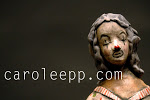Have you always wanted to know how glazes REALLY work?
Online Glaze Calculation Course!
Understanding our glazes is the most powerful thing we can do to make our work our own.
Yet how many of us really understand how our glazes work?
Ceramic Materials Workshop is here to help.
You can take our world renowned glaze calculation classes online, right now.
Designed for ceramicists of all levels, our Glaze Calculation courses will change your studio FOREVER.
After years of teaching ceramic materials courses in a traditional classroom lecture, Matt Katz developed and designed the Ceramic Materials Workshop specifically for online educational access. These innovative courses have proved highly successful; student evaluations consistently praised Matt for his knowledge of ceramic materials and their applications and applauded him for his concise and personable presentation of challenging technical content. The online format proved exceptionally conducive to robust group interaction and discussion. I highly recommend these classes.
-Anne Currier, Professor Emerita,
Alfred University
Watch a Sample Lecture:
Full details and sign up here.
technical tuesday: Simple Glaze Sprayer for Pottery
This video was featured in Ceramic Arts Daily : http://ceramicartsdaily.org/pottery-m…
More Bridges’ work can be seen in http://www.bridgespottery.com
Tools can be purchased from http://bambootools.com
monday morning eye candy: Keith Haring
“I began by visiting a workshop on the outskirts of Milano where they
produce terracotta pieces. I chose several vases of different sizes and shapes
and began the next day to systematically sand, wash, and then embellish the
surface with marking ink. The largest of these was big enough for me to stand
inside of. There were several small vases which I was attracted to because
of their similarity to the shape of nuclear cooling towers. The confrontation
between the history of vase paintings and the contemporary approach of drawing
with marker and the mixture of contemporary and ancient symbols produces
an ironic mixture of opposites.” –Keith Haring (via www.haring.com)
emerging artist: Lynne Hobaica
call for entry: The 3rd international Zanesville Prize
The 3rd international Zanesville Prize
for Contemporary Ceramics Competition & Exhibit
returns to the Seilers’ Studio and Gallery on October 8, 2017.
New for 2017:
There will be four categories of entries – each will receive a Best Of award –
except for the Zanesville Prize winner, which will be selected from the four category winners:
Functional
Sculptural
Vessel
Mixed Media
We anticipate accepting 75-100 entries into the exhibit.
Jurors:
Mary Jo Bole, Columbus, Ohio
Leslie Ferrin, North Adams, Massachusetts
Tony Marsh, Long Beach, California
Key dates:
Call for Entries Opens: Monday, April 17, 2017
Call for Entry Deadline: Monday, July 17, 2017
Finalists announced: August 21, 2017
Open Gala Reception/Awards Ceremony: October 7, 2017
Exhibit at Seilers’ Studio: October 8 through November 18, 2017
The Zanesville Museum of Art will exhibit the top award winners
and the People’s Choice award from November 22, 2017 to January 13, 2018.
call for entry: 2018 NCECA ANNUAL VISUAL VOICES: TRUTH NARRATIVES
Society for Contemporary Craft
2100 Smallman St
Pittsburgh, PA 15222
ENTRY DEADLINE: Wednesday, June 14, 2017 (midnight MDT)
If you encounter problems and require technical assistance with submission contact [email protected]
EXHIBITION DATES: March 14–August 18, 2018
ABOUT THE NCECA ANNUAL
The recently refreshed format of the NCECA Annual blends impactful attributes of invitational and open juried models of exhibition development. NCECA’s aspiration for this exhibition is to enable exceptional work to represent clay’s concerns for craft and material expression in concert with meaningful content and conceptual rigor. NCECA remains committed to the belief that relatively under-exposed artists will have opportunities to present their work with that of more established and already recognized emerging creators in the field.
The NCECA Annual is developed through the vision of a single curator/juror who generates an organizing concept for the exhibition and invites five artists whose work will frame curatorial ideas. Additional works and artists for the exhibition will be selected through an open call for submissions. The curator/juror will review these entries and make final selections for the exhibition.
ABOUT THE EXHIBITION’S CURATOR, WINNIE OWENS-HART
Winnie Owens Hart is recognized as an educator, artist, filmmaker, author and critical thinker in matters of clay, art and culture. She taught at Howard University for more than 37 years and has conducted research, exhibited, and presented lectures internationally. Her career in ceramics began very early in life and has continued professionally since the 1970s. She opened her first studio in 1972 in Alexandria, Virginia. As a young art student, she imagined what pot-making and art must be like in Africa and then pursued that vision throughout undergraduate school. While teaching crafts in a Philadelphia public school, she discovered a film that demonstrated some African women hand-building a huge pot. She realized her dream of studying women’s traditional pottery techniques and culture in 1977, when she was selected to represent the United States and exhibit her ceramic work at FESTAC in Lagos, Nigeria. After receiving an NEA Fellowship she returned that summer to work in the village. Eventually she took a job with the federal government of Nigeria teaching ceramics at a nearby university to enable her to continue apprenticing traditional pottery, and was eventually accepted as part of the community’s pottery culture. For the past 10 years she has worked with women in a pottery village in Ghana. A published author, Owens-Hart has curated exhibitions primarily focused on contemporary African American artists and has also produced documentary films, including Style & Technique-Four Pottery Villages and The Traditional Potters of Ghana-The Women of Kuli. Over more than four decades, her work has been exhibited nationally and internationally with work in the collections of the Smithsonian and Kohler, universities and private collections.
Full details here.



















